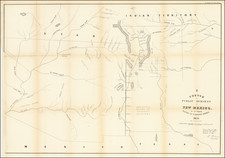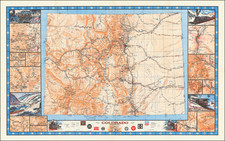"This is the First Map of Denver." - Everett D. Graff --
Heralded by Graff as the first map of Denver, the 1859 "Plan of the Cities of Denver, Auraria and Highland," by H.M. Fosdick and L.N. Tappan, stands as a seminal piece in the cartographic history of that city and the Pikes Peak Gold Rush.
The map was the brainchild of civil engineer Henry Fosdick, who leveraged his own surveying in its design. Despite its minimalist detailing—numbered blocks, street names, and bridge locations—it earned the recognition of being the official federal government map of the area encompassed by the original congressional grant. The map's creation followed the establishment of the Denver City Town Company by William H. Larimer, Jr., who named the town Denver in a bid to court favor with James W. Denver, the former Kansas Territory governor. The map showcases the distinct grid layouts of Denver, Auraria, and Highlands, each within their unique geographical contexts, encapsulating a historical moment when Denver and Auraria were rival towns before their eventual merger in April 1860.
Manuscript Annotations
The present example is embellished with scattered pencil notations that provide insights into the changing landscape and socio-economic dynamics of the cities. They mark changes in land ownership, detail the outlines of city blocks, and highlight individual structures. Of particular interest is a set of four blocks shaded and labeled "Camp Weld," a significant military encampment of the period, and red pencil marks on a specific lot. South of Cherry Creek in Auraria, further annotations outline lots, buildings, and partial subdivisions of city blocks, painting a dynamic picture of the developing urban environment.
Among the annotations on the map is at the top right, placed over the printed signature of Henry Fosdick, is a large square, with the name "Bassett." This is a reference to the lands of Captain Peleg Tripp Bassett, T., a Director of the Denver City Town Company and its Recorder in autumn of 1858. On April 16, 1859, Captain Bassett was shot and mortally wounded by J.W. Scudder, treasurer of Auraria Town Company. Scudder would later be acquitted of the murder, as it was determined to be an act of self defense.
Colorado Gold Rush
The map was created during the peak of the Colorado Gold Rush (often called the Pikes Peak Gold Rush), a period of rapid population growth and fervent land speculation. The discovery of gold in 1858 attracted a flood of prospectors and settlers to the area, leading to the rapid development of settlements like Denver, Auraria, and Highland. As such, this map not only charts the early urban planning of these burgeoning cities but also encapsulates the frenzied economic and social changes of the era. It captures the essence of a boomtown atmosphere, where ownership of lots could change rapidly and new buildings sprung up seemingly overnight.
Camp Weld
On the present map, Camp Weld is noted in pencil manuscript in an early hand. Camp Weld was strategically established on a thirty-acre tract of land situated to the east of the Platte River and north of Denver's 8th Avenue Bridge. This military outpost, commissioned in 1861 by Colorado's Territorial Governor Gilpin, was a defensive initiative to safeguard the Colorado Territory from potential Southern assaults during the American Civil War. Nestled just beyond the confines of U.S. Marshal Hunt's homestead, Camp Weld served as a vital hub for the organization and rigorous training of Union troops, fortifying them for the defense of the Union cause.
Rarity
As documented in the Graff Catalog (1386), the map eluded researchers for most of the last half of the 19th century, finally being rediscovered in the vaults of the Denver Land Office in 1897.
Today the map remains extremely rare. It last appeared for sale in the Jay T. Snider Collection of Historical Americana Sale, Christie's New York, 21 June 2005, where it made $31,200. Before that, RBH records only a 1980 Howell catalog entry for $1,650.
OCLC's records are somewhat difficult to trace but it seems that there are examples at Denver Public Library, Yale University, and the Rosenstock Map Collection at the Autry Museum. We are aware of at least one example in a private collection in Colorado.
Conclusion
As the first map of Denver, it stands as one of the holy grails of Colorado map collecting. The map remains a fascinating testament to Denver's early history, offering valuable insights into the region's urban and social development.
Lewis Northey Tappan was an abolitionist, politician, and Colorado pioneer and entrepreneur.
After and early business career in Boston, Lewis went to Kansas in 1857 to join his cousin, Samuel Forster Tappan (1831–1913), who was already heavily involved in the Free-State movement as clerk of the Topeka Constitutional Convention and later, acting Speaker of the State House of Representatives. Lewis became Secretary of the Senate under the Topeka Constitution and one of the Fort Scott Treaty Commissioners.
Lewis was one of the fifteen armed men who went to Lecompton to recover the infamous candle box containing fraudulent election returns, the discovery of which caused the downfall of the Kansas pro-slavery party.
In 1859, Lewis moved to Colorado Territory where he joined the first city government of Denver, built its first frame building with his brother George Hooper Tappan (1833–1865), and operated the first store in the Colorado Territory. He was a member of Governor Gilpin's council and a staff member to Governor Cummings.
Tappan, along with several other town promoters, met in Denver City and organized the Colorado City Town Company on August 11, 1859, founding Colorado City on August 12. A few days later, on August 15, 1859, Tappan and many of the same eager town promoters organized the El Paso Claim Club, a vigilante form of civil government, to record real estate claims and settle land disputes. Tappan not only became the Town Company's director, secretary, and treasurer, but he also became the Claim Club's director, secretary, and recorder. Colorado City is now a national historic district within Colorado Springs, where Tappan operated a general and mining supplies store.
Tappan was one of the first 3 white men to enter the region known as "Garden of the Gods", which they named. The name of the park goes back to August 1859.











![[DeWitt Clinton Copy] An Account of Expeditions to the Sources of the Mississippi, and through the Western Parts of Louisiana, to the Sources of the Arkansaw, Kans, La Platte, and Pierre Jaun, Rivers During the years 1805, 1806 and 1807. And a Tour through the Interior Parts of New Spain. in the year 1807.](https://storage.googleapis.com/raremaps/img/small/81745.jpg)



![[Poster] IBM Advertising - Boulder, Colorado](https://storage.googleapis.com/raremaps/img/small/78793.jpg)
![[ Denver ] The City of Denver Published by H.L. Thayer . . .](https://storage.googleapis.com/raremaps/img/small/98923.jpg)